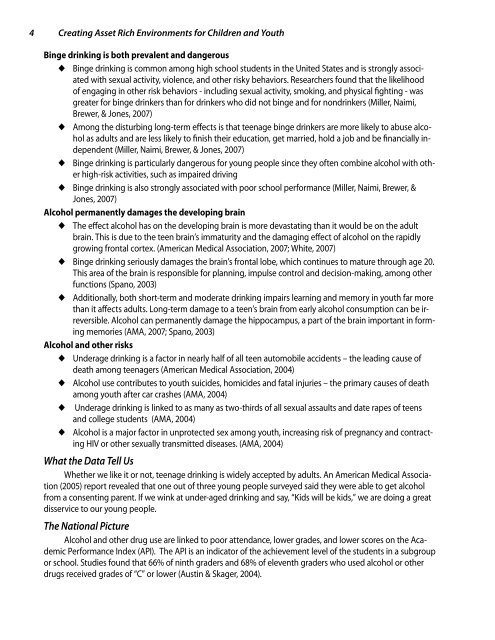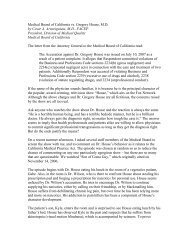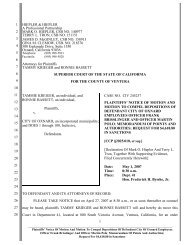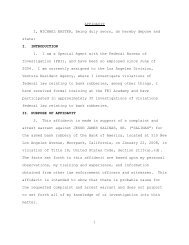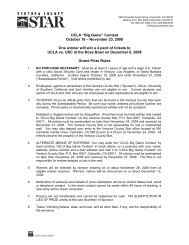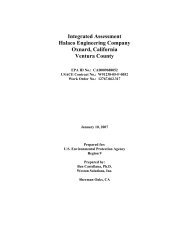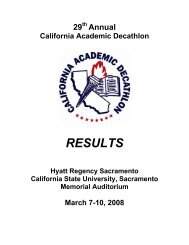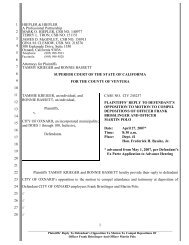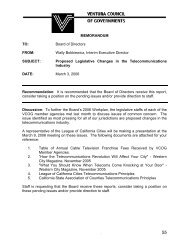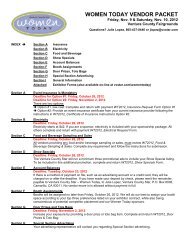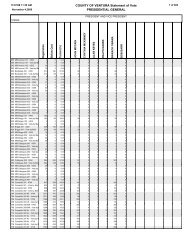for Children and Youth - Ventura County Star
for Children and Youth - Ventura County Star
for Children and Youth - Ventura County Star
Create successful ePaper yourself
Turn your PDF publications into a flip-book with our unique Google optimized e-Paper software.
4 Creating Asset Rich Environments <strong>for</strong> <strong>Children</strong> <strong>and</strong> <strong>Youth</strong><br />
Binge drinking is both prevalent <strong>and</strong> dangerous<br />
◆◆ Binge drinking is common among high school students in the United States <strong>and</strong> is strongly associated<br />
with sexual activity, violence, <strong>and</strong> other risky behaviors. Researchers found that the likelihood<br />
of engaging in other risk behaviors - including sexual activity, smoking, <strong>and</strong> physical fighting - was<br />
greater <strong>for</strong> binge drinkers than <strong>for</strong> drinkers who did not binge <strong>and</strong> <strong>for</strong> nondrinkers (Miller, Naimi,<br />
Brewer, & Jones, 2007)<br />
◆◆ Among the disturbing long-term effects is that teenage binge drinkers are more likely to abuse alcohol<br />
as adults <strong>and</strong> are less likely to finish their education, get married, hold a job <strong>and</strong> be financially independent<br />
(Miller, Naimi, Brewer, & Jones, 2007)<br />
◆◆ Binge drinking is particularly dangerous <strong>for</strong> young people since they often combine alcohol with other<br />
high-risk activities, such as impaired driving<br />
◆◆ Binge drinking is also strongly associated with poor school per<strong>for</strong>mance (Miller, Naimi, Brewer, &<br />
Jones, 2007)<br />
Alcohol permanently damages the developing brain<br />
◆◆ The effect alcohol has on the developing brain is more devastating than it would be on the adult<br />
brain. This is due to the teen brain’s immaturity <strong>and</strong> the damaging effect of alcohol on the rapidly<br />
growing frontal cortex. (American Medical Association, 2007; White, 2007)<br />
◆◆ Binge drinking seriously damages the brain’s frontal lobe, which continues to mature through age 20.<br />
This area of the brain is responsible <strong>for</strong> planning, impulse control <strong>and</strong> decision-making, among other<br />
functions (Spano, 2003)<br />
◆◆ Additionally, both short-term <strong>and</strong> moderate drinking impairs learning <strong>and</strong> memory in youth far more<br />
than it affects adults. Long-term damage to a teen’s brain from early alcohol consumption can be irreversible.<br />
Alcohol can permanently damage the hippocampus, a part of the brain important in <strong>for</strong>ming<br />
memories (AMA, 2007; Spano, 2003)<br />
Alcohol <strong>and</strong> other risks<br />
◆◆ Underage drinking is a factor in nearly half of all teen automobile accidents – the leading cause of<br />
death among teenagers (American Medical Association, 2004)<br />
◆◆ Alcohol use contributes to youth suicides, homicides <strong>and</strong> fatal injuries – the primary causes of death<br />
among youth after car crashes (AMA, 2004)<br />
◆◆ Underage drinking is linked to as many as two-thirds of all sexual assaults <strong>and</strong> date rapes of teens<br />
<strong>and</strong> college students (AMA, 2004)<br />
◆◆ Alcohol is a major factor in unprotected sex among youth, increasing risk of pregnancy <strong>and</strong> contracting<br />
HIV or other sexually transmitted diseases. (AMA, 2004)<br />
What the Data Tell Us<br />
Whether we like it or not, teenage drinking is widely accepted by adults. An American Medical Association<br />
(2005) report revealed that one out of three young people surveyed said they were able to get alcohol<br />
from a consenting parent. If we wink at under-aged drinking <strong>and</strong> say, “Kids will be kids,” we are doing a great<br />
disservice to our young people.<br />
The National Picture<br />
Alcohol <strong>and</strong> other drug use are linked to poor attendance, lower grades, <strong>and</strong> lower scores on the Academic<br />
Per<strong>for</strong>mance Index (API). The API is an indicator of the achievement level of the students in a subgroup<br />
or school. Studies found that 66% of ninth graders <strong>and</strong> 68% of eleventh graders who used alcohol or other<br />
drugs received grades of “C” or lower (Austin & Skager, 2004).


